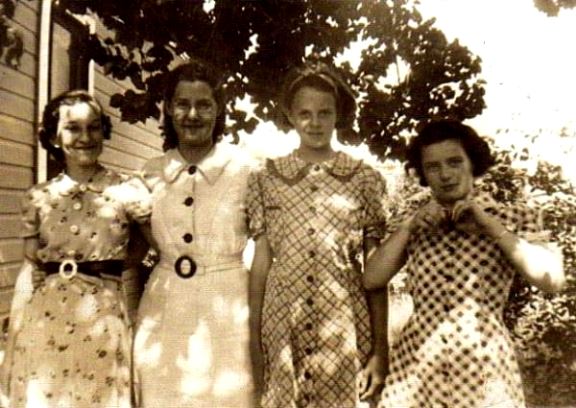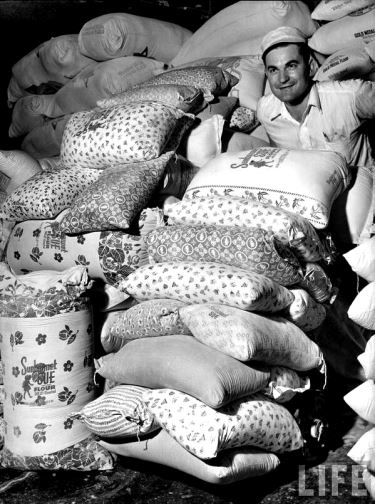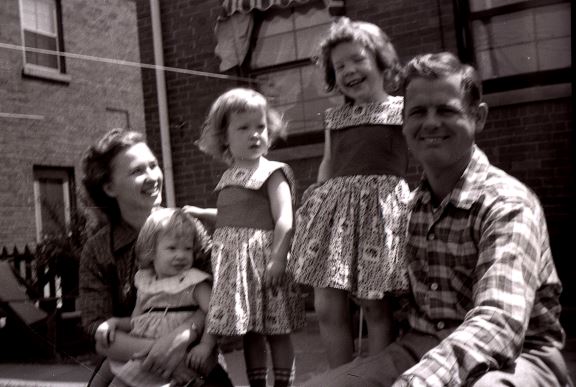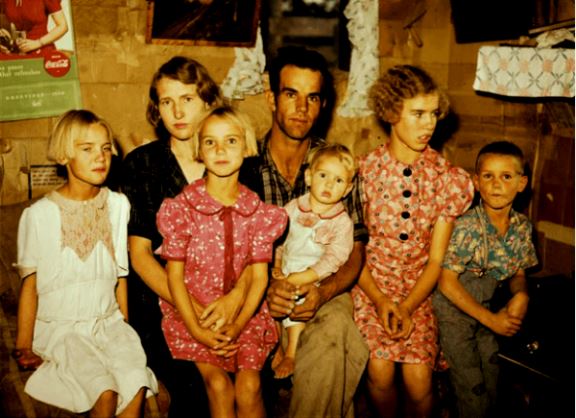Flour Sack Clothes
by Gary Wright
“The only thing we have to fear is fear itself.”
— F.D. Roosevelt

Times were tough during the depression of the 1930’s. Throughout American history there have been economic downturns, bank panics, recessions and financial crises on a regular, almost rhythmic basis. By far the worst though, was the one which began on that ‘Black Tuesday’ in October 1929 and lasted mid-way through World War II. It was so intense and affected so many people world-wide for so long that it had a superlative added to its name. It became known as the Great Depression to distinguish it from all others.
Although the Depression affected the entire United State and even worldwide, its face seems to have been permanently imprinted on the lives of the South. In many ways, though, much of the South was not as fully impacted as the rest of the country, for many Southerners either lived on farms or had ready access to rural vegetables, produce, livestock, wild plants, and wild game. Those who had such access could supplement their diets and lives with dandelion salad, squirrel and dumplings, frog legs, and fried muskrat.
Early in, the women of the South, always resourceful and ever self-reliant, noted that many of their staples: rice, flour, cornmeal, livestock feed, and dried beans came in bags made of textile, mainly cotton. Because the staples, especially flour, were finely grained, the cotton weave was also fine. At the darkest hour these women, with very little spendable money in their budgets, began using these sacks to make clothing. It wasn’t long before the companies selling these products took notice. In an effort to attract more customers, these companies started dying the sacks into attractive colors. Other companies took note and the ‘flour sack race’ was on and became very competitive. Soon Pillsbury, Gold Medal, Pure-as-Snow, and dozens of other flour companies were printing bags with a variety of exquisite prints and designs.

Southern women used the cotton sacks, as well, to make pillow cases, shirts, table cloths, handkerchiefs, and dish towels. As the women expanded their uses of the flour sacks, the manufacturers increased competitiveness with other companies vying to sell more of their product. Soon, beautiful prints and patterns were on the sacks and the product was labeled in washable ink. Next, came booklets with ideas and instructions on what to make and how to make items. Government agencies began instructional classes on usage of ‘flour sacks,’ along with a host of other tips on how to stretch limited budgets. It’s estimated that during the Depression, 3.5 million women and children were wearing clothing and using items made from flour sacks.
It may seem odd to us now, but during the hard times of the Great Depression wearing ‘flour sacks’ wasn’t just a trend, it was a necessity. People of the time were reluctant to accept welfare or handouts so the idea of using ‘flour sacks’ was not so preposterous. As the prints and designs became more varied and better quality, the trend only increased. Patterns and designs became ever more varied and attractive as the companies tried to appeal to as many age groups and all sectors of the buying public. With such good designs and skill with a sewing machine, the women produced quality clothes that matched outfits sold in stores for huge prices. Such clothing was worn with pride and could not be distinguished from high quality outfits. Often, though, there was a dead giveaway when several children from the same family could be seen together — wearing clothing made from the same print, color, or design.

Nothing was wasted during those days. After mending worn or tattered clothing and handing it down to a younger brother or sister, the material finally couldn’t be worn any longer. But still, it was not wasted; parts were ‘pieced’ together and made into quilts for further use. The remainder was used as shop rags, dusting cloths, or bedding for animals. The motto of the day was ‘mend, recycle, and re-use.’
Some women were so proficient and artistic at sewing cotton sacks that they started hiring out to make or mend clothes for neighbors or for sale to the public. A cottage industry was born. ‘Flour sack’ clothing was so prevalent, especially in the rural South, that many children never had ‘store bought’ clothing until high school or beyond. Marilyn Brevard, a minister’s daughter from Red Hill, Alabama states proudly, “We grew up poor but we didn’t know it. We weren’t ashamed because everybody else was as poor as we were.”
It is good to see that Americans are beginning to recycle and to husband natural resources. That is a noble idea, however, recycling and re-using is simply a holdover idea from the Great Depression when it was not trendy but a matter of survival. It has become a part of our American heritage!

When World War II was thrust upon us in 1941, rationing began. Cotton was one item that was in short supply and much-needed to make uniforms and other items for the soldiers and sailors. People were more than willing to give up their cotton sacks for the war effort. So, ‘flour sacks’ gave way to paper bags as containers for flour and cornmeal, while animal feed and dried beans were packaged in coarse burlap bags.
The War slowly brought the Great Depression to an end as the military industry provided jobs and economic relief for millions. But for a few brief years in the misery and heartache of the Great Depression, the women used their ingenuity and skills to provide a bit of color and style to an otherwise drab, weary existence. It’s nothing short of amazing to realize that something so basic as chicken feed, flour and cornmeal could have brought such a relief to the misfortunate, depression-era South and become so much a part of our rich, American history.
Images from Google Images


